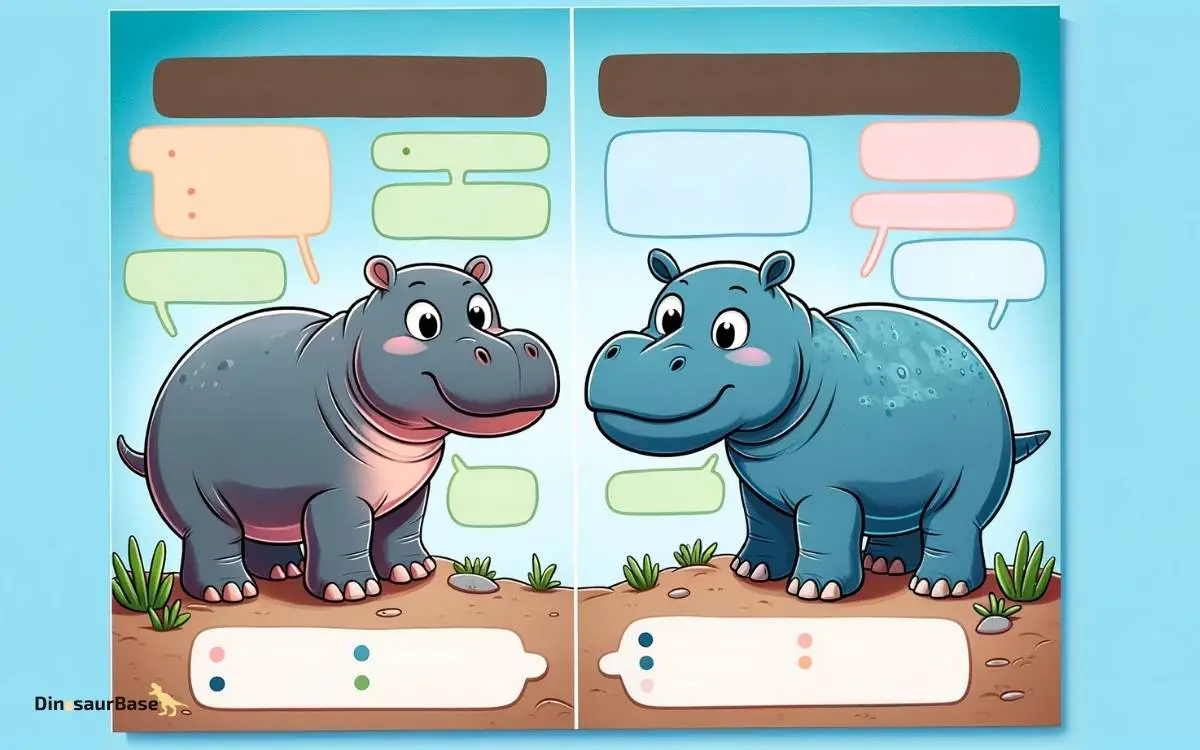How to Distinguish Between a Hippo And a Dinosaur
Hippos are living, semi-aquatic mammals with barrel-shaped bodies. Dinosaurs were terrestrial, often gigantic reptiles that are now extinct.
Identifying the differences between a hippo and a dinosaur is straightforward given their distinct characteristics. Hippos, short for hippopotamuses, belong to today’s wildlife, inhabiting rivers and lakes in Africa.
They feature massive bodies, short legs, and large mouths. Dinosaurs, on the other hand, roamed the earth millions of years ago, during the Mesozoic Era.
From the towering Brachiosaurus to the fearsome Tyrannosaurus Rex, dinosaurs varied greatly in size and form; unlike the uniformity seen in hippos.
Dinosaurs typically have unique skeletal structures, including varied arrangements of limbs, that set them apart from modern-day animals.
Understanding these key traits is essential for distinguishing between the ancient creatures and the river giants of today.

Spotting The Differences: Hippos Vs Dinosaurs
Dinosaurs have always sparked the imagination, and hippos often remind us of these ancient creatures. Yet, despite superficial similarities, they are vastly different.
To distinguish between a modern-day hippo and a prehistoric dinosaur, we need to examine their physical traits and the habitats they thrived in.
Physical Traits
Hippos and dinosaurs display distinct physical characteristics making it easy to differentiate between them. Let’s delve into their unique features:
- Size: Dinosaurs ranged from the size of chickens to the imposing, massive Argentinosaurus.
- Skin: Hippos have thick, smooth skin while many dinosaurs had scales or even feathers.
- Teeth: Hippos showcase large canines and incisors; different dinosaurs had various teeth shapes suited to their diets.
Habitat And Environment
The environments in which hippos and dinosaurs lived offer clear distinctions:
| Hippos | Dinosaurs |
|---|---|
| Live near water sources such as rivers and lakes in Africa. | Dinosaurs roamed diverse landscapes; from lush forests to arid deserts. |
| Presently restricted to Earth’s current ecosystems. | Lived during various geological periods, with environments that have changed greatly. |
Understanding these factors simplifies the identification process between the two.
The Hippopotamus: A Modern-day Giant
The Hippopotamus: A Modern-Day Giant, may strike you as a creature from another era. With their massive bodies and mouths wide enough to fit a small child, hippos are indeed reminiscent of the prehistoric beasts that once roamed the Earth.
However, despite their dinosaur-like appearance, hippos are very much a part of our modern world.
Let’s explore the key characteristics that set these majestic animals apart and delve into the natural habitat where they thrive.
Key Characteristics
- Size: Adults can weigh up to 3,000 kg.
- Teeth: Their teeth grow throughout life, with canines reaching up to 50 cm.
- Skin: Nearly hairless, with a pinkish-gray hue.
- Behavior: Known for being highly territorial in the water.
These mammals have short legs but move easily both in water and on land. Their specific gravity allows them to sink and walk on the riverbed. This characteristic is unique and sets them apart from any creature from the dinosaur age.
Natural Habitat
| Continent | Regions | Water Sources |
|---|---|---|
| Africa | Sub-Saharan countries | Lakes, rivers, swamps |
Hippos find their home in the warm climates of Africa. They spend up to 16 hours a day submerged in rivers and lakes to keep their massive bodies cool under the hot African sun.
At dusk, they venture onto land to graze, covering distances of up to 10 km to consume roughly 40 kg of grass.
Dinosaurs: Creatures From The Past
Dinosaurs roamed the Earth millions of years ago. These majestic creatures are long extinct. They belong to a different era, far before humans or hippos existed. Knowing this helps us spot the differences between dinosaurs and modern animals.
Variety Of Species
Dinosaurs came in all shapes and sizes. Some were as small as chickens, while others towered over buildings.
Scientists classify them into two main groups: Saurischia and Ornithischia. These groups differ in hip structures and other features.
- Saurischia: Lizard-hipped dinosaurs like Tyrannosaurus Rex.
- Ornithischia: Bird-hipped species like Stegosaurus.
Fossil Evidence
Fossils provide clues to what dinosaurs looked like. When we dig up bones, we find solid proof of their existence. Fossilized bones, eggs, and footprints tell a story from millions of years ago.
| Fossil Type | What It Tells Us |
|---|---|
| Bones | Size, shape, and structure of the dinosaur. |
| Eggs | Reproduction methods and nesting behavior. |
| Footprints | Walking patterns and possible group behavior. |
Time Periods: Separating Fact From Fiction
Imagine stepping back in time. Would you see a hippo or a dinosaur? It’s time we cleared up some myths. Let’s dive into history and uncover when these creatures really existed. Ready to explore?
Evolutionary Timelines
Understanding when different species roamed the earth is key. Animals evolve over millions of years. This shapes their timeline. Let’s get our facts straight on this one.
- First Dinosaurs: Appeared around 230 million years ago.
- First Hippos: Walked the earth about 15 million years ago.
Two different times, so no mix-ups. Hippos came a long time after dinosaurs had gone. They never met!
Extinction Events
Big events in history wiped out certain species. This includes dinosaurs. But were hippos affected? Let’s see.
| Event | Dinosaurs | Hippos |
|---|---|---|
| K-T Extinction | Yes, goodbye dinosaurs! | No, hippos weren’t around. |
| Ice Age | Already extinct. | Yes, hippos faced challenges. |
Two big extinctions, different impacts. Dinosaurs vanished in the first, while hippos got through the second. They survived!
Understanding Popular Misconceptions
Understanding Popular Misconceptions about prehistoric creatures and existing wildlife can be quite fascinating.
It’s easy to get confused between a hippopotamus and a dinosaur, especially when they’re depicted in various forms of media.
In this section, we will debunk these myths and clarify the unique characteristics that set these two apart. Let’s dive into the world of these massive beings and clear the air on their differences.
Media Influence
The media plays a big role in how we perceive animals. Movies and cartoons often show dinosaurs and hippos in a way that isn’t accurate. But remember:
- Hippos are real animals you can see today.
- Dinosaurs are extinct and lived millions of years ago.
Always check if the source is showing true facts about these creatures.
Common Mix-ups
Here are some mix-ups people might have:
| Feature | Hippo | Dinosaur |
|---|---|---|
| Size | Big, but not as huge as dinosaurs | Some were gigantic |
| Time Period | Modern times | Millions of years ago |
| Teeth | Large, curved tusks | Varied, from sharp to flat |
| Skin | Smooth, thick | Could be scaly or feathery |
Kids, check out this table when you see an animal in a movie or book.
Educational Resources For Accurate Identification
Do you want to tell apart a hippo from a dinosaur? It’s essential and fun! Use the right educational resources to become an expert at this. You will feel like a time traveler! Let’s explore how museums and scientific literature can help.
Museums And Exhibits
Check out museums for real-life clues. They are treasure troves! Here’s what they offer:
- Fossil displays show dinosaurs’ bones.
- Models compare a hippo’s size to a dinosaur.
- Interactive stations teach about prehistoric life.
Below is a handy table of activities you can find:
| Museum Section | Activities |
|---|---|
| Dinosaur Hall | Fossil Examination, Dinosaur Reconstructions |
| Hippo Habitat | Live Specimens, Habitat Simulation |
Scientific Literature
Books and articles are great for learning. They explain the differences clearly. Look for these topics:
- Hippo and Dinosaur Anatomy
- Dinosaur Extinction Theories
- Hippo Evolutionary History
Try to read simple books with lots of pictures. They make learning easier. Find books that have:
- Clear labels on pictures
- Fun facts sidebars
- Questions to test your knowledge
Frequently Asked Questions Of How To Distinguish Between A Hippo And A Dinosaur
Which Dinosaur Looks Like A Hippo?
The Lisowicia bojani, a Triassic period dicynodont, resembled a hippo in its build and appearance.
Are Hippopotamuses Considered Dinosaurs?
No, hippopotamuses are not considered dinosaurs. They are large mammals and evolved long after dinosaurs became extinct.
What Did Prehistoric Hippos Look Like?
Prehistoric hippos resembled modern-day hippos, being large, water-loving mammals. They had barrel-shaped bodies, massive jaws, and short, stubby legs designed for life mostly in rivers and lakes. Their physical appearance was adapted for semi-aquatic habitats, aiding in swimming and feeding.
What Distinguishes A Dinosaur?
Dinosaurs are a group of prehistoric reptiles characterized by their distinct upright stance, where legs extend directly beneath the body. This distinctive posture supports their massive size, which varied among species, and is a key feature that separates them from other ancient reptiles.
Conclusion
Distinguishing hippos from dinosaurs can be simple yet fascinating. Remember, hippos are modern, water-loving mammals.
Dinosaurs were diverse and roamed ancient landscapes. Use this guide to spot key differences easily. Sharing your newfound knowledge can inspire others and ignite conversations.
Keep exploring the wonders of wildlife with curiosity!


